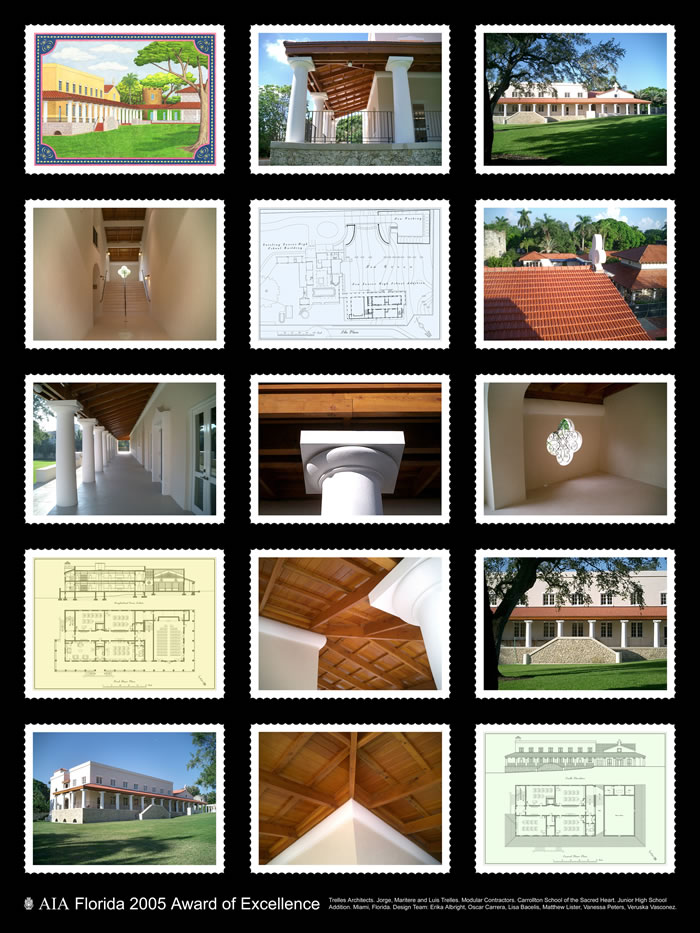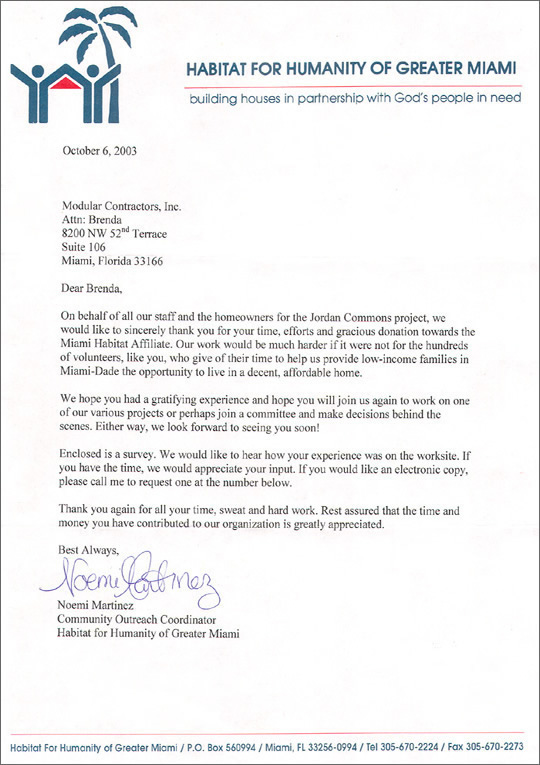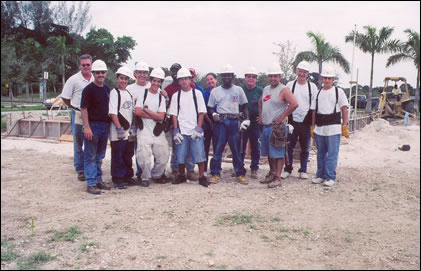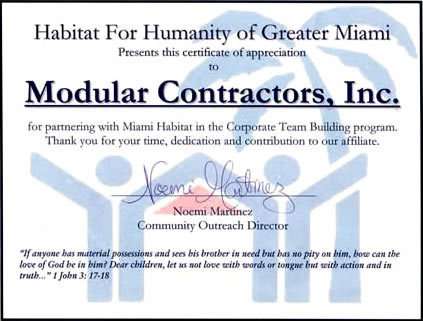Press Releases and Construction News
Carnival Cruise Line Science and Technology Building
Modular Contractors of Miami recently completed the $10 million, 28,000 square foot Carnival Cruise Line Science and Technology Building at St. Thomas University. Begun in 2006, the fast track project was completed on time and within budget due to extensive planning, staging, and coordination. Including design, permitting and construction, the entire project lifecycle was less than two years. Modular Contractors’ Principal Shaun Nowrouzi states, “Planning and staging this type of high technology project went far beyond the typical construction process.”
The project’s mechanical and electrical systems, ductwork, piping, and power requirements are extremely unique. Modular’s approach hinged on first understanding from the user’s perspective the operational principles and interrelationships of the building’s systems and components. Dr. Edward Ajhar, Dean of the School of Science & Technology commented, “The Modular team’s understanding of the ‘why and how’ behind every facet of the building was key to the successful outcome.”
The building features teaching laboratories and teaching support facilities for biology, chemistry, computer science, and physics. All laboratories were constructed with scientific built-in cabinets and casework outfitted with acid-resistant utility services and accessories (air, gas, vacuum, cap sinks, electrical and data ports). Each chemistry/ biology laboratory is equipped with high technology laboratory furniture and a series of fume hoods connected to a central exhaust system that constantly cycles negative airflow. The exhaust system, fresh air intake systems, and chilled water systems are all monitored and actuated by phoenix valves and JohnsonControl System.
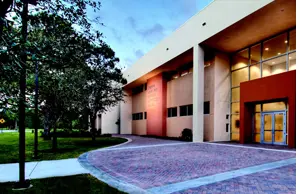

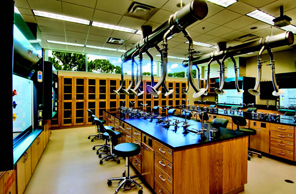
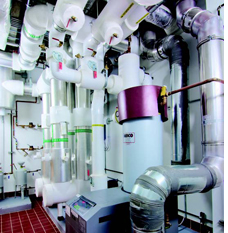
Shaun Nowrouzi comments, “If I could sum this project up in one word it would be a team. We came together as a team. We worked as a team. We succeeded as a team.” Nowrouzi concluded, “Every person who played a part in bringing this project to fruition should feel good about their accomplishment. This structure will benefit the University and this community for years to come.”
“It is our belief that the more students we are able to prepare for careers in the in-demand fields of science and technology, the bigger the impact we will have on the students’ communities,” said Rev. Monsignor Franklyn M. Casale, President of St. Thomas University. The Carnival Cruise Line Science and Technology Building at St. Thomas University—Flawless!
Carnival Cruise Line Science and Technology Building at St. Thomas University
The Story of Good Planning and Better Execution!
by Gregory T. DuBose, Bella Group, Inc.
Construction is construction, or so the popular thought process goes. Combine four walls, a roof, an interior build-out, and a few aesthetic touches, and some people would say you have a completed construction project. In reality, some projects present much more of a challenge. The $10 million, 28,000 square foot Carnival Cruise Line Science and Technology Building at St. Thomas University serves as a prime example of a successful, albeit challenging construction project.
Projects from the science and technology sector require the skills of many disciplines. These projects succeed only under careful direction, planning, and staging by a team with a wealth of experience in this niche market space. The team’s lead professional, no matter how knowledgeable, must be willing to learn. Every one of these projects, no matter how similar, is equally dissimilar. New challenges abound, and so too do new opportunities. The basis for success with these projects must reside plainly and firmly in fundamental planning measures.
Modular Contractors of Miami, Florida, has proven itself time and again as the preeminent construction manager and general contractor to facilitate these complicated and multi-faceted projects. Modular Contractors’ Principal, Shaun Nowrouzi, states, “One must understand that planning and staging a project such as this goes far beyond what the typical construction process encompasses.” The approach to this type of high-technology, the user-specific project is to first understand from the user’s perspective, the operational principles and interrelationships of the many systems and components. Among the things that make these projects so different are the mechanical and electrical systems, ductwork and piping, power requirements, and other features which will ultimately yield the optimum facility for the end-user. Correspondingly, the completed project must manifest an utterly safe and secure environment. Every effort is taken to protect students, the public, and the environment.
Dr. Edward Ajhar, Dean of the School of Science & Technology, commented, “Modular Contractors has been magnificent since day one. The entire team has proven ultra-sensitive to the University’s needs.” Ultimately, these are the science department’s, faculty’s, and student's needs. He continued, “The Modular team’s understanding of this project was clearly evident. Their understanding of the ‘why and how’ behind every aspect of the project has been key to a successful outcome. That understanding afforded Modular the ability to know when it was feasible to value engineer a system or component in the project and when there was no possible compromise.”
An easy example is scientific cabinetry in the building. Dr. Ajhar commented, “Irrespective of price, we simply couldn’t go to a typical cabinetmaker. Modular understood this because they understood scientific casework necessitates strict adherence to specific standards.” Conversely, truly understanding the project also allowed Modular’s team to propose alternatives that otherwise would not have been considered.
Begun in 2006, this project was on an extremely fast track schedule and could not have been completed on time without the extensive planning, staging, and coordination of the entire interdisciplinary team. The entire project lifecycle was approximately two years—a nearly unbelievable start-to-finish timeframe encompassing design, permitting, and construction. Equally astonishing is the fact the project was completed without any change orders to the Guaranteed Maximum Price (“GMP”). This was made possible by Modular Contractors’ proactive approach to value engineering and their understanding of the unique demands, challenges, and opportunities this project presented.
St. Thomas University’s Science and Technology Building consists of computer science laboratories, chemistry and biology laboratories, advanced chemistry and biology laboratories, as well as advanced research laboratories and general classrooms. In order for Modular Contractors to complete the project to specification, the company had to first possess an intimate understanding of every aspect of the Science and Technology Building’s functionality requirements. Shaun Nowrouzi commented, “We brought the entire user group together so we could learn firsthand how each of the building’s rooms and labs would be used. These sessions proved invaluable. Rather than interpreting the intended use based on a set of preconceived beliefs and guesswork, we were getting the information directly from the users.” He continued, “At its core, we were able to further customize an already exceedingly custom build-out. The advantage of getting everyone on the same page and staying on the same page is improved value engineering. We weren’t looking to make any component or system ‘cheaper’ we were looking to bring the University greater value through efficiency, durability, and longevity.” This is what Modular Contractors refers to as working with the owner’s mindset.
Scope of Work—Concept
To understand the intricacies of the project, an understanding of the scope of work is required. All laboratories were constructed with scientific built-in cabinets and casework outfitted with acid-resistant utility services and accessories (air, gas, vacuum, cap sinks, electrical and data ports). Each chemistry/biology laboratory is equipped with high technology laboratory furniture and a series of fume hoods connected to a central exhaust system that constantly cycles negative airflow. The exhaust system, fresh air intake systems, and chilled water systems are monitored and actuated by hi-tech air control systems known commonly in the industry as Phoenix Valves. These systems work in tandem with occupant load sensors dedicated to each lab, as well as an advanced control system that actuates efficient and balanced negative airflow.
Pre-Construction Phase—Planning
With a clear understanding of the scope of work, Modular Contractors moved confidently into the pre-construction phase. Nowrouzi, describing the process stated, “This is where the project really began to take shape. Armed with the understanding of scope we took as much information as possible from the design team and other team members to prepare our budget. We constantly reviewed preliminary drawings for constructability, budget tracking, and value engineering.”
Guaranteed Maximum Price (GMP)—No Turning Back
Preparing the GMP pricing package for subcontractors was an intense period in the overall project. Nowhere is the subcontractors’ understanding of a project more important than with a technology-intensive project such as this. With drawings and specifications at 80% completion, Modular Contractors brought together a team consisting of their own estimator, project manager, superintendent, and an independent consultant hired to review plans and specifications. Subsequently, the team drafted independent “critic sheets” to clarify any ambiguity in documents for the bidding process. This method, termed scrubbing, was essential to Modular’s ability to interpret and convey the vision of the project for bidding purposes at the subcontractor level. Again, it was important the subcontractors not just review a set of plans, without fully understanding the intended uses for the completed project. Only after first gaining its own understanding from the user group could Modular properly convey the project particulars.
Conflicts in the scope of work among trades are avoided with this methodology and the project timeline benefits exponentially. Not crossing tasks makes projects flow smoother and faster. Working within such a tight timeline, every one of the small but important steps Modular made initially, added precious days and weeks to the schedule. Eliminate just one of these steps and the completion date of July 30th would have been jeopardized. For St. Thomas University’s Science and Technology Building the actual construction phase may have been the easiest (if this is fathomable) piece of the pie. Because of excellent project planning and a team approach, many potential sticking points were avoided. Avoiding these project bottlenecks was the key component in completing a seamless project on time, within budget, and without the all-too-frequent start/stops of indecision and confusion. Terry O’Connor, St. Thomas University Vice President & Chief Financial Officer, states, “Budget and timeframe were our biggest worries. From day one you got the feeling that Modular knew the project in a way that almost guaranteed success. The team knew the project. They were committed to the project and they stayed on time and on budget. I highly recommend Modular Contractors.” He continued, “It was the manner in which they conducted themselves. They displayed a committed focus to getting the job done right.”
Construction
With so much work has gone into the planning, pre-construction, and scrubbing stages of the project, the process of actual construction was a seamless and rewarding affair. “This is where we saw the fruits of our efforts. Here, it was abundantly clear that the deliberate and methodical approach we took with this project was the only approach that could have given the University the project they’d envisioned, and given it to them in the timeframe they required,” states Nowrouzi. The construction phase centered squarely on project coordination, quality control, staging, and communication at all levels of the project team.
Communication was highly interactive and culminated in each day’s activity review. Again, this real-time, ongoing and constant monitoring of the project’s progress was essential to completing the project in the allotted time frame. The danger of not conducting a daily review was the potential to allow even the smallest factor to run off schedule. Doing so would have surely resulted in a missed deadline. To understand the full breadth of the feat Modular Contractors accomplished with this project, understand this: permitting took three months. The full construction lifecycle start to finish lasted a mere 13 months.
Achievement
Not the fast-track lifecycle, nor the excellent planning, nor even the finished product tells the full story of this multifaceted project. Shaun Nowrouzi comments, “If I could sum this project up in one word it would be a team. We came together as a team. We worked as a team. While the list is too numerous to name, I must mention both consulting engineer Frank Moses and architect Jack Ponikvar. Frank designed the mechanical, plumbing, and electrical systems. Jack was the architect in charge of all architectural elements for the project.” Both played an integral role in completing this project on time and within budget.
“I take great pride in the quality project this team has facilitated. I believe every person who played a part in bringing this project to fruition should feel good about their accomplishment. It is quite an achievement to have delivered a structure that will benefit the University and this community for years to come. The contributions these students will make to their fields are endless.” The Carnival Cruise Line Science and Technology Building at St. Thomas University—a story of good planning and better execution!
AIA Florida 2005 Award of Excellence
Trelles Architects. Jorge, Maritere and Luis Trelles. Modular Contractors. Carrollton School of Sacred Heart. Junior Highschool Addition. Miami, Florida.
